Strategies for Conducting Blended Learning in VET: A Comparison of Award-Winning Courses and Daily Courses
Abstract
1. Introduction
2. Literature Review
2.1. Strategies for Conducting Blended Learning in VET
2.2. Video Analysis in Evidence-Based Education Research
2.3. Research Gap and Present Study
3. Methods
3.1. Design Process
3.2. Datasets and Analysis of Classroom Videos
3.2.1. Datasets
3.2.2. Data Coding
3.2.3. Data Analysis of Classroom Videos
3.3. Participants and Data Analysis of the Questionnaire
3.3.1. Participants
3.3.2. Measurement
3.3.3. Data Analysis of the Questionnaire
4. Results
4.1. Results of General Blended Learning Strategies Constructed from Video Analysis
4.1.1. General Strategies Based on Descriptive Statistical Results About Questioning
4.1.2. General Strategies Based on LSA Results About Feedback
4.1.3. Results on the General Blended Learning Strategies After Integration
4.2. Results of Specific Blended Learning Strategies Constructed from Video Analysis
4.2.1. Specific Strategies Based on LSA Results About Knowledge Transfer
4.2.2. Results on the Specific Blended Learning Strategies After Integration
4.3. Questionnaire Results on the Effectiveness of Blended Learning Strategies
5. Discussion
6. Conclusions, Implications, and Limitations
Author Contributions
Funding
Institutional Review Board Statement
Informed Consent Statement
Data Availability Statement
Acknowledgments
Conflicts of Interest
Appendix A
| Award-Winning Courses | Daily Courses | |
|---|---|---|
| Type1 teacher– student dialogue |  | 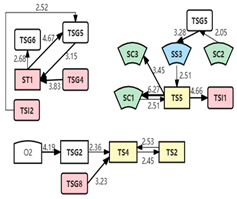 |
| Type2 teacher demonstration | 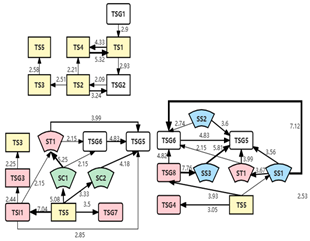 |  |
| Type3 student- independent operation | 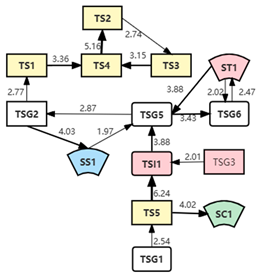 | 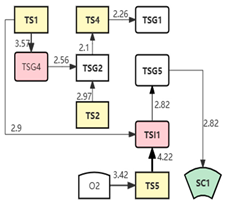 |
References
- Adam, M. S., Abd Hamid, J., Khatibi, A., & Azam, S. F. (2023). Autonomous motivation in blended learning: Effects of teaching presence and basic psychological need satisfaction. Learning and Motivation, 83, 101908. [Google Scholar] [CrossRef]
- Ajzen, I. (1991). The theory of planned behavior. Organizational Behavior and Human Decision Processes, 50(2), 179–211. [Google Scholar] [CrossRef]
- Ajzen, I., & Fishbein, M. (1980). Understanding attitudes and predicting behavior. Prentice-Hal. [Google Scholar]
- Ameloot, E., Rotsaert, T., Ameloot, T., Rienties, B., & Schellens, T. (2024). Supporting students’ basic psychological needs and satisfaction in a blended learning environment through learning analytics. Computers & Education, 209, 104949. [Google Scholar]
- Anthonysamy, L., Koo, A. C., & Hew, S. H. (2020). Self-regulated learning strategies and non-academic outcomes in higher education blended learning environments: A one decade review. Education and Information Technologies, 25(5), 3677–3704. [Google Scholar] [CrossRef]
- Barron, B., Pea, R., & Engle, R. (2013). Advancing understanding of collaborative learning with data derived from video records. In C. E. Hmelo-Silver, C. A. Chinn, C. K. K. Chan, & A. O’Donnell (Eds.), The international handbook of collaborative learning (pp. 203–219). Routledge. [Google Scholar]
- Bernard, R. M., Borokhovski, E., Schmid, R. F., Tamim, R. M., & Abrami, P. C. (2014). A meta-analysis of blended learning and technology use in higher education: From the general to the applied. Journal of Computing in Higher Education, 26, 87–122. [Google Scholar] [CrossRef]
- Bin, E., Islam, A. A., Gu, X., Spector, J. M., & Wang, F. (2020). A study of Chinese technical and vocational college teachers’ adoption and gratification in new technologies. British Journal of Educational Technology, 51(6), 2359–2375. [Google Scholar] [CrossRef]
- Bliuc, A. M., Casey, G., Bachfischer, A., Goodyear, P., & Ellis, R. A. (2012). Blended learning in vocational education: Teachers’ conceptions of blended learning and their approaches to teaching and design. The Australian Educational Researcher, 39(2), 237–257. [Google Scholar] [CrossRef]
- Boon, N. S. (2021). Developing a hybrid learning curriculum framework for schools. IBE UNESCO International Bureau of Education, 1–27. Available online: https://unesdoc.unesco.org/ark:/48223/pf0000377482 (accessed on 21 January 2025).
- Brockmann, M., Clarke, L., & Winch, C. (2008). Knowledge, skills, competence: European divergences in vocational education and training (VET)—The English, German and Dutch cases. Oxford Review of Education, 34(5), 547–567. [Google Scholar] [CrossRef]
- Bruggeman, B., Tondeur, J., Struyven, K., Pynoo, B., Garone, A., & Vanslambrouck, S. (2021). Experts speaking: Crucial teacher attributes for implementing blended learning in higher education. The Internet and Higher Education, 48, 100772. [Google Scholar] [CrossRef]
- Butz, N. T., & Stupnisky, R. H. (2017). Improving student relatedness through an online discussion intervention: The application of self-determination theory in synchronous hybrid programs. Computers & Education, 114, 117–138. [Google Scholar]
- Bünning, F. (2007). Approaches to action learning in technical and vocational education and training (TVET) (p. 37). InWEnt. [Google Scholar]
- Cai, S., Niu, X., Wen, Y., & Li, J. (2023). Interaction analysis of teachers and students in inquiry class learning based on augmented reality by iFIAS and LSA. Interactive Learning Environments, 31(9), 5551–5567. [Google Scholar] [CrossRef]
- Castro, R. (2019). Blended learning in higher education: Trends and capabilities. Education and Information Technologies, 24(4), 2523–2546. [Google Scholar] [CrossRef]
- Chen, G., Chan, C. K. K., Chan, K. K. H., Clarke, S. N., & Resnick, L. B. (2020). Efficacy of video-based teacher professional development for increasing classroom discourse and student learning. Journal of the Learning Sciences, 29(4–5), 642–680. [Google Scholar] [CrossRef]
- Chen, H., & He, Z. (2020, September 25–27). Blended Learning design and praxis for the coordinated development of theory and practice-take vocational education as an example. 2020 International Conference on Modem Education and Information Management (ICMEIM) (pp. 671–675), Dalian, China. [Google Scholar]
- Cheng, K. H., & Tsai, C. C. (2019). A case study of immersive virtual field trips in an elementary classroom: Students’ learning experience and teacher-student interaction behaviors. Computers & Education, 140, 103600. [Google Scholar]
- Chiu, T. K. (2021). Digital support for student engagement in blended learning based on self-determination theory. Computers in Human Behavior, 124, 106909. [Google Scholar] [CrossRef]
- Chiu, T. K. (2022). Applying the self-determination theory (SDT) to explain student engagement in online learning during the COVID-19 pandemic. Journal of Research on Technology in Education, 54(supp. 1), S14–S30. [Google Scholar] [CrossRef]
- Cui, Y., Wang, W., & Han, X. (2025). Research on multi-type mixed teaching mode of higher vocational college’s classroom in digital era. Chinese Vocational and Technical Education (Chinese Journal), (3), 68–74. [Google Scholar]
- Cui, Y., Zhou, Q., & Han, X. (2022, December 16–17). Blended learning in VET: How does the teacher plan to use and how appropriate is it? The 11th International Conference of Educational Innovation through Technology (EITT), New York, NY, USA. [Google Scholar]
- Deci, E. L., & Ryan, R. M. (1987). The support of autonomy and the control of behavior. Journal of Personality and Social Psychology, 53(6), 1024–1037. [Google Scholar] [CrossRef]
- Dey, P., & Bandyopadhyay, S. (2019). Blended learning to improve quality of primary education among underprivileged school children in India. Education and Information Technologies, 24(3), 1995–2016. [Google Scholar] [CrossRef]
- Dukuzumuremyi, S., & Siklander, P. (2018). Interactions between pupils and their teacher in collaborative and technology-enhanced learning settings in the inclusive classroom. Teaching and Teacher Education, 76, 165–174. [Google Scholar] [CrossRef]
- Eggers, J. H., Oostdam, R., & Voogt, J. (2021). Self-regulation strategies in blended learning environments in higher education: A systematic review. Australasian Journal of Educational Technology, 37(6), 175–192. [Google Scholar] [CrossRef]
- Feng, L., Zhen, Z., & Hu, E. (2021). An analysis of blended teaching mechanism from the perspective of “learning activity-centered instructional design”. e-Education Research (Chinese Journal), 42(11), 100–106. [Google Scholar]
- Feng, X., Xie, J., & Liu, Y. (2017). Using the community of inquiry framework to scaffold online tutoring. International Review of Research in Open and Distributed Learning, 18(2), 162–188. [Google Scholar] [CrossRef]
- Flanders, N. A. (1963). Intent, action and feedback: A preparation for teaching. Journal of Teacher Education, 14(3), 251–260. [Google Scholar] [CrossRef]
- Garrison, D. R., & Kanuka, H. (2004). Blended learning: Uncovering its transformative potential in higher education. Internet and Higher Education, 7(2), 95–105. [Google Scholar] [CrossRef]
- Gibbons, A. S. (2020). What is instructional strategy? Seeking hidden dimensions. Education Technology Research and Development, 68, 2799–2815. [Google Scholar] [CrossRef]
- Gorard, S., See, B. H., & Siddiqui, N. (2020). What is the evidence on the best way to get evidence into use in education? Getting evidence into use in education. Review of Education, 8(2), 570–610. [Google Scholar] [CrossRef]
- Hao, T., & Pilz, M. (2021). Attractiveness of VET in China: A study on secondary vocational students and their parents. Journal of Education and Work, 34(4), 472–487. [Google Scholar] [CrossRef]
- Hämäläinen, R., De Wever, B., Malin, A., & Cincinnato, S. (2015). Education and working life: VET adults’ problem-solving skills in technology-rich environments. Computers & Education, 88, 38–47. [Google Scholar]
- Hoekstra, A., Kuntz, J., & Newton, P. (2018). Professional learning of instructors in vocational and professional education. Professional Development in Education, 44(2), 237–253. [Google Scholar] [CrossRef]
- IBM Corp. (2012). IBM SPSS statistics for windows [Computer software] (Version 21.0). IBM Corp. [Google Scholar]
- Jayalath, J., & Esichaikul, V. (2020). Gamification to enhance motivation and engagement in blended elearning for technical and vocational education and training. Technology, Knowledge and Learning, 27(1), 91–118. [Google Scholar] [CrossRef]
- Jensen, K. B., & Helles, R. (2017). Speaking into the system: Social media and many-to-one communication. European Journal of Communication, 32(1), 16–25. [Google Scholar] [CrossRef]
- Jerrim, J. (2024). Are satisfied teachers better teachers? International evidence from the TALIS video study. Teaching and Teacher Education, 148, 104687. [Google Scholar] [CrossRef]
- Jossberger, H., Brand-Gruwel, S., van de Wiel, M. W., & Boshuizen, H. P. (2020). Exploring students’ self-regulated learning in vocational education and training. Vocations and Learning, 13(1), 131–158. [Google Scholar] [CrossRef]
- Jung, I., Choi, S., Lim, C., & Leem, J. (2002). Effects of different types of interaction on learning achievement, satisfaction and participation in web-based instruction. Innovations in Education and Teaching International, 39(2), 153–162. [Google Scholar] [CrossRef]
- Karasova, J. (2023). Supporting learners through effective communication: Student teachers’ communication strategies to address learner behaviour. Australian Journal of Teacher Education, 48(3), 19–36. [Google Scholar] [CrossRef]
- Khoza, H. C., & Msimanga, A. (2022). Understanding the nature of questioning and teacher talk moves in interactive classrooms: A case of three South African teachers. Research in Science Education, 52(6), 1717–1734. [Google Scholar] [CrossRef]
- Kim, M. K., Kim, S. M., Khera, O., & Getman, J. (2014). The experience of three flipped classrooms in an urban university: An exploration of design principles. The Internet and Higher Education, 22, 37–50. [Google Scholar] [CrossRef]
- Kucuk, S., & Sisman, B. (2017). Behavioral patterns of elementary students and teachers in one-to-one robotics instruction. Computers & Education, 111, 31–43. [Google Scholar]
- Kumar, S., Martin, F., Budhrani, K., & Ritzhaupt, A. (2019). Award-winning faculty online teaching practices: Elements of award-winning courses. Online Learning, 23(4), 160–180. [Google Scholar] [CrossRef]
- Lee, Y., Kinzie, M. B., & Whittaker, J. V. (2012). Impact of online support for teachers’ open-ended questioning in pre-k science activities. Teaching & Teacher Education, 28, 568–577. [Google Scholar]
- Luo, R. Z., & Zhou, Y. L. (2024). The effectiveness of self-regulated learning strategies in higher education blended learning: A five years systematic review. Journal of Computer Assisted Learning, 40, 3005–3029. [Google Scholar] [CrossRef]
- Ma, J., Han, X., Yang, J., & Cheng, J. (2015). Examining the necessary condition for engagement in an online learning environment based on learning analytics approach: The role of the instructor. The Internet and Higher Education, 24, 26–34. [Google Scholar] [CrossRef]
- Ma, J., Zheng, M., & Feng, X. (2025). A situated expectancy-value theoretical perspective of teaching presence and student engagement in blended learning environments. The Internet and Higher Education, 64, 100974. [Google Scholar] [CrossRef]
- Mailizar, M., Almanthari, A., & Maulina, S. (2021). Examining teachers’ behavioral intention to use E-learning in teaching of mathematics: An extended TAM model. Contemporary Educational Technology, 13(2), ep298. [Google Scholar] [CrossRef]
- Ministry of Education of the People’s Republic of China. (2020, August 13). Announcement of the National Vocational College Teachers’ Teaching Skills Competition. Available online: http://www.moe.gov.cn/s78/A07/A07_sjhj/202008/t20200814_478105.html (accessed on 21 January 2025).
- Miyazoe, T., & Anderson, T. (2011). Anonymity in blended learning: Who would you like to be? Journal of Educational Technology & Society, 14(2), 175–187. [Google Scholar]
- Moore, M. G. (1989). Three types of interaction. The American Journal of Distance Education, 3(2), 1–6. [Google Scholar]
- Müller, C., Mildenberger, T., & Steingruber, D. (2023). Learning effectiveness of a flexible learning study programme in a blended learning design: Why are some courses more effective than others? International Journal of Educational Technology in Higher Education, 20(1), 10. [Google Scholar] [CrossRef]
- Orozco, M., Gijbels, D., & Timmerman, C. (2019). Empirical conceptualisation of integrative learning. A focus on theory-practice integration in technical vocational education and training. Vocations and Learning, 12(3), 405–424. [Google Scholar] [CrossRef]
- Ostinelli, G., & Crescentini, A. (2021). Policy, culture and practice in teacher professional development in five European countries. A comparative analysis. Professional Development in Education, 50(1), 74–90. [Google Scholar] [CrossRef]
- Pica, T. (1987). Second-language acquisition, social interaction, and the classroom. Applied Linguistics, 8(1), 3–21. [Google Scholar] [CrossRef]
- Sackett, G. P. (1978). Observing behaviour: Theory and applications in mental retardation (Vol. 1). University Park Press. [Google Scholar]
- Schaap, H., Baartman, L., & De Bruijn, E. (2012). Students’ learning processes during school-based learning and workplace learning in vocational education: A review. Vocations and Learning, 5, 99–117. [Google Scholar] [CrossRef]
- Shelton-Strong, S. J. (2022). Advising in language learning and the support of learners’ basic psychological needs: A self-determination theory perspective. Language Teaching Research, 26(5), 963–985. [Google Scholar] [CrossRef]
- Sikorski, T. R., & Straus, A. (2025). Comparing curriculum coherence and student coherence seeking: A secondary analysis of the TIMSS video study. Journal of Curriculum Studies, 1–24. [Google Scholar] [CrossRef]
- Smirani, L., & Boulahia, J. (2022). Using the unified theory of acceptance and use of technology to investigate the adoption of open educational resources by faculty members. International Journal of Information Technology, 14(6), 3201–3211. [Google Scholar] [CrossRef]
- Song, Y. (2022). Research and practice of AI enabled new classroom teaching. Global Education (Chinese Journal), 51(10), 19–29. [Google Scholar]
- Song, Y., Zhang, S., & Liu, B. (2023). Investigating the dialogic patterns of mathematics lessons in different stages of education. The Journal of Educational Research, 116(2), 77–89. [Google Scholar] [CrossRef]
- Stewart, V. (2015). Made in China: Challenge and innovation in China’s vocational education and training system. International comparative study of leading vocational education systems. National Center on education and the Economy. [Google Scholar]
- Stroet, K., Opdenakker, M. C., & Minnaert, A. (2013). Effects of need supportive teaching on early adolescents’ motivation and engagement: A review of the literature. Educational Research Review, 9, 65–87. [Google Scholar] [CrossRef]
- Su, C. Y., & Chao, C. M. (2022). Investigating factors influencing nurses’ behavioral intention to use mobile learning: Using a modified unified theory of acceptance and use of technology model. Frontiers in Psychology, 13, 673350. [Google Scholar] [CrossRef]
- Su, Y. L., & Reeve, J. (2011). A meta-analysis of the effectiveness of intervention programs designed to support autonomy. Educational Psychology Review, 23, 159–188. [Google Scholar] [CrossRef]
- Tan, S. C., Wang, X., & Li, L. (2022). The development trajectory of shared epistemic agency in online collaborative learning: A study combing network analysis and sequential analysis. Journal of Educational Computing Research, 59(8), 1655–1681. [Google Scholar] [CrossRef]
- Thai, N., Wever, B. D., & Valcke, M. (2017). The impact of a flipped classroom design on learning performance in higher education: Looking for the best ‘blend’ of lectures and guiding questions with feedback. Computers & Education, 107, 113–126. [Google Scholar]
- Tlili, A., Sun, T., Denden, M., Kinshuk, Graf, S., Fei, C., & Wang, H. (2023). Impact of personality traits on learners’ navigational behavior patterns in an online course: A lag sequential analysis approach. Frontiers in Psychology, 14, 1071985. [Google Scholar] [CrossRef]
- Tripp, T., & Rich, P. (2012). Using video to analyze one’s own teaching. British Journal of Educational Technology, 43(4), 678–704. [Google Scholar] [CrossRef]
- van der Stap, N., van den Bogaart, T., van Ginkel, S., Rahimi, E., & Versendaal, J. (2024). Towards teaching strategies addressing online learning in blended learning courses for adult-learners. Computers & Education, 219, 105103. [Google Scholar]
- Vanslambrouck, S., Zhu, C., Lombaerts, K., Philipsen, B., & Tondeur, J. (2018). Students’ motivation and subjective task value of participating in online and blended learning environments. The Internet and Higher Education, 36, 33–40. [Google Scholar] [CrossRef]
- Vaughan, N. (2015). Designing for an inquiry based approach to blended and online learning. Revista Eletrônica de Educação, 9(3), 30–47. [Google Scholar] [CrossRef]
- Venkatesh, V., Morris, M. G., Davis, G. B., & Davis, F. D. (2003). User acceptance of information technology: Toward a unified view. MIS Quarterly, 27(3), 425–478. [Google Scholar] [CrossRef]
- Wang, G. (2021). They are bad seeds: Stereotyping habitus in Chinese VET colleges. British Journal of Sociology of Education, 42(7), 1008–1021. [Google Scholar] [CrossRef]
- Worley, P. (2015). Open thinking, closed questioning: Two kinds of open and closed question. Journal of Philosophy in Schools, 2(2), 17–29. [Google Scholar] [CrossRef]
- Wu, D., Ge, X., Dang, M., Li, X., & Pang, C. (2022). A systematic literature review of video analysis of classroom in China: An analysis based on the literature of 2010–2020. Global Education (Chinese Journal), 51(10), 30–44. [Google Scholar]
- Wu, S. Y. (2021). How teachers conduct online teaching during the COVID-19 pandemic: A case study of Taiwan. Frontiers in Education, 6, 675434. [Google Scholar] [CrossRef]
- Xu, J. (2021, January 21–23). Investigation and optimization research on online and offline blended learning of higher vocational english from the perspective of CoI algorithm. 2021 International Conference on Advances in Optics and Computational Sciences (Vol. 1865, p. 022016), Ottawa, ON, Canada. [Google Scholar]
- Yan, G. (2019). Is the tradition of “chalk and talk” teaching in colleges outdated: Analysis on the effectiveness of different methods and technology in undergraduate classroom teaching. Research in Educational Development (Chinese Journal), 39(23), 1–9. [Google Scholar]
- Yang, C., Guo, R., & Cui, Y. (2023). What affects vocational teachers’ acceptance and use of ICT in teaching? A large-scale survey of higher vocational college teachers in China. Behavioral Sciences, 13(1), 77. [Google Scholar] [CrossRef]
- Ye, L., Kuang, M., & Liu, S. (2022). ICT self-efficacy, organizational support, attitudes, and the use of blended learning: An exploratory study based on English teachers in basic education. Frontiers in Psychology, 13, 941535. [Google Scholar] [CrossRef]
- Zografos, N. (2023). Student teachers’ experiences of online learning during emergency remote teaching to inform future teaching practice [Master’s Thesis, European University of Cyprus (Cyprus)]. [Google Scholar]

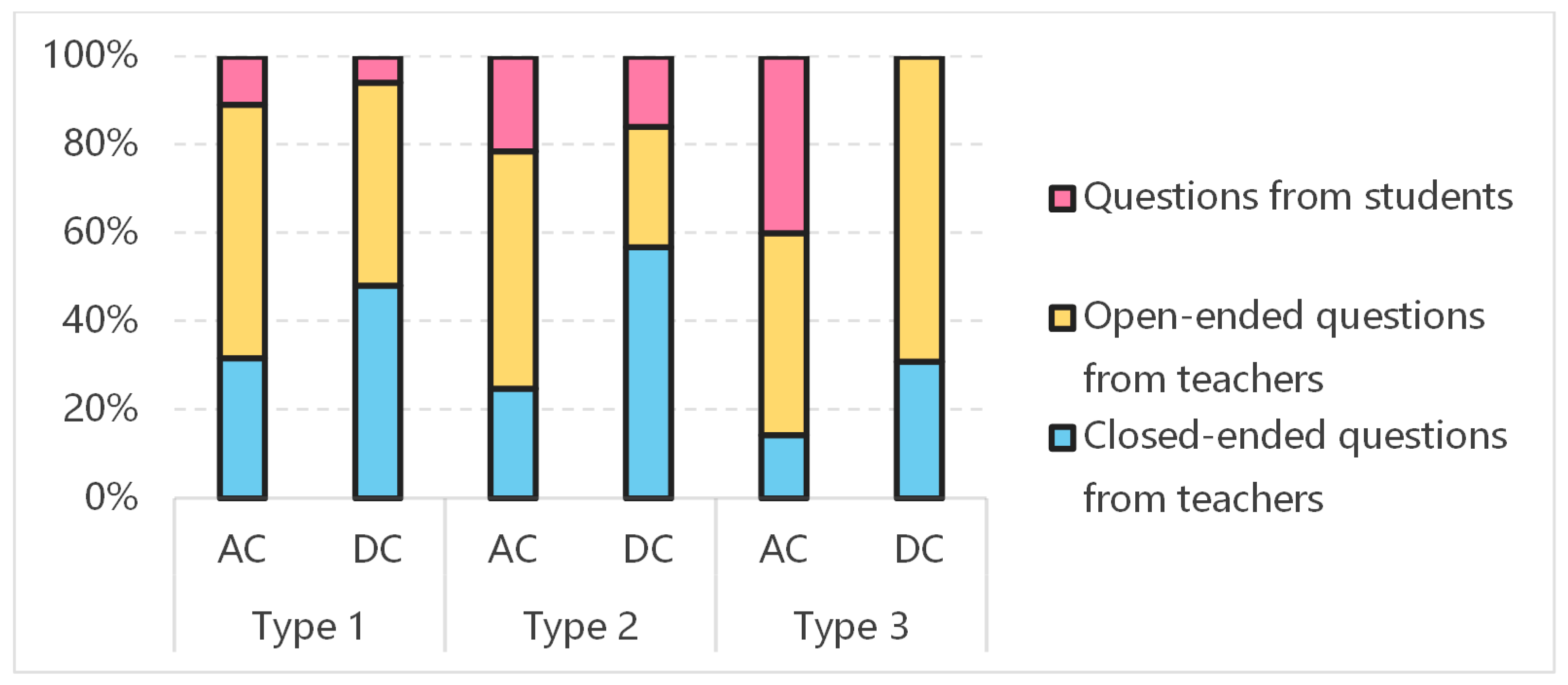


| Types of Courses | Type1 | Type2 | Type3 |
|---|---|---|---|
| Award-winning courses | 138,967 s | 69,327 s | 17,172 s |
| Daily courses | 106,476 s | 27,690 s | 25,993 s |
| Dimension | Category | Coding Indicators | |
|---|---|---|---|
| Teacher– student interaction | Teacher-to-student interaction | Teacher operation (TS1) Teacher relates content to work context (TS2) Teacher expresses ideas about content (TS3) Teacher states content (TS4) Teacher states rules and action requirements (TS5) | |
| Student-to-teacher interaction | Student presentation (ST1) | ||
| Teacher– student bidirectional interaction | Individual interaction (1 to 1) | Student operation while teacher gives personalized guidance (TSI1) Student discussion while teacher gives personalized guidance (TSI2) | |
| Social interaction (1 to N) | Authoritative discussion (teacher asks and answers themselves and students respond with yes or no) (TSG1) Teacher-led dialogue (teacher asks and students respond) (TSG2) Student-led dialogue (students ask and teacher responds) (TSG3) Student presentations interspersed with teacher comments (TSG4) Teacher feedback on students’ previous responses (TSG5) Teacher gives emotional expression (e.g., praise) for student performance (TSG6) Teacher gives classroom prompts while students operate (no direct guidance) (TSG7) Students operate under the guidance of the teacher (TSG8) | ||
| Student–student interaction | Student discussion (SS1) Role-playing (SS2) Peer assessment (SS3) | ||
| Student and content interaction | Student operation (teacher non-participant behavior) (SC1) Students complete homework (teacher non-participant behavior) (SC2) Students view information (teacher non-participant behavior) (SC3) | ||
| Others | Teacher discourse unrelated to content (e.g., maintaining order) (O1) Silence that does not contribute to the lesson (O2) Silence that contributes to the lesson (e.g., thinking) (O3) Student signing in (O4) | ||
| Sample Size (N) | Percentage | ||
|---|---|---|---|
| Gender | Male | 57 | 31.1% |
| Female | 126 | 68.9% | |
| Age | Lower than 26 years old | 2 | 1.1% |
| 26–40 years old | 117 | 63.9% | |
| 41–55 years old | 57 | 31.1% | |
| More than 55 years old | 7 | 3.8% | |
| Academic title | Assistant lecturer | 5 | 2.7% |
| Lecturer | 95 | 51.9% | |
| Associate professor | 41 | 22.4% | |
| Professor | 30 | 16.4% | |
| Years of teaching experience | Less than 1 years | 5 | 2.7% |
| 1–3 years | 32 | 17.5% | |
| 4–6 years | 21 | 11.5% | |
| 7–10 years | 25 | 13.7% | |
| 11–20 years | 82 | 44.8% | |
| More than 20 years | 18 | 9.8% | |
| Closed-Ended Questions from Teachers | Open-Ended Questions from Teachers | Questions from Students | F | p | |||||
|---|---|---|---|---|---|---|---|---|---|
| Time Period (s) | Percentage | Time Period (s) | Percentage | Time Period (s) | Percentage | ||||
| Type1 | AC | 305 | 0.113 | 554 | 0.205 | 105 | 0.039 | 53.04 | <0.001 |
| DC | 373 | 0.138 | 356 | 0.132 | 46 | 0.017 | |||
| Type2 | AC | 81 | 0.030 | 176 | 0.065 | 70 | 0.026 | 42.23 | <0.001 |
| DC | 68 | 0.025 | 32 | 0.012 | 19 | 0.007 | |||
| Type3 | AC | 27 | 0.010 | 86 | 0.032 | 76 | 0.028 | 94.56 | <0.001 |
| DC | 57 | 0.021 | 127 | 0.047 | 0 | 0 | |||
| Behavioral Sequence | Type1 | Type2 | Type3 | |||
|---|---|---|---|---|---|---|
| AC | DC | AC | DC | AC | DC | |
| TS2 → TS3 | 3.01 * | −0.2 | 2.51 * | −0.2 | 2.74 * | −0.4 |
| TSG5 → TSG6 | −0.94 | 0.35 | 0.2 | −0.25 | 3.43 * | −0.56 |
| TSG6 → TSG5 | 7.17 * | 0.42 | 4.83 * | −0.25 | 1.73 | −0.56 |
| Stage | Teaching Strategy | Situation | No. | Explanation of Teacher Actions | SDT | |
|---|---|---|---|---|---|---|
| During class | Introduce | Focus on the link between classroom activities and pre-course activities. | T | 1 | At the beginning of each class, teachers should offer explanations and feedback on student activities and their results, bridging the connection between in-class and out-of-class and online and offline learning experiences. | CS |
| Help students understand the connection between what they have learned and the workplace and enhance the attractiveness of the tasks by relating them to local features or daily life. | 2 | Teachers should connect lessons to real-world applications in the workplace and daily life, helping students realize the situations and problems the lessons can assist them with and motivating their active participation. | AS RS | |||
| Teaching new knowledge | Focus on teacher–student interaction, encouraging student participation by emphasizing the importance of the activity and providing opportunities to express themselves and communicate. | F | 3 | Teachers need to encourage teacher–student and student–student interaction rather than one-way information delivery. E.g., clearly explaining the purpose and meaning of the activity to enhance student engagement, emphasizing opportunities for self-expression, and questioning during the process. | ||
| Issuing tasks | Design tasks and problems orientated to the needs of real jobs, including clear explanations of the rules and requirements. | T | 4 | The tasks or problems presented should be closely related to practical application, and the rules should be clearly stated to regulate students’ actions. It aims to motivate them to integrate what they have learned with the needs of real workplaces and prepare them for future employment. | CS | |
| Implementation | Offer students well-structured guidance. | 5-1 | Teachers should provide relevant support and scaffolding when students operate. | |||
| 5-2 | Offering timely, targeted, and personalized guidance is crucial, rather than delayed and assumptive group feedback. | |||||
| Feedback | Feedback reflects encouragement of emotions. | F | 6 | When giving feedback on students’ answers, teachers should pay attention to providing more emotional incentives and more encouraging language to students. | CS RS | |
| Feedback reflects an attitude of equal respect for students. | 7 | Instead of offering vague praise like “good” or “very good,” teachers should combine the content and students’ performance to provide clear and constructive feedback to prevent negative feelings associated with superficial praise. | ||||
| Design the feedback process flexibly to support assessment for learning and the integration of knowledge and evaluation. | T | 8 | After the student-led activities, teachers should first guide students to evaluate each other’s performances and then give feedback on students’ responses and mutual assessment to strengthen cognition and meta-cognition. | CS AS RS | ||
| Extension | Allow sufficient time for students to consolidate their understanding and make improvements. | F | 9 | Allow time for problem-solving and consolidation following the feedback on students’ actions. | CS AS | |
| Throughout all phases of classroom | Employ a variety of questioning styles during teacher–student interactions. | 10-1 | Balance questions between group and individual contexts based on the questioning purpose: memorizing and closed questions are suitable for assessing collective understanding, while speculative and open-ended questions are suitable for individual in-depth understanding. | AS | ||
| 10-2 | Teachers should consciously use open-ended questions to stimulate students’ thinking during interaction. | |||||
| Integrating real workplace situations or business mentors into the school’s teaching and learning process. | T | 11-1 | Show videos featuring presentations about companies or artisans to motivate students and illustrate job requirements and professionalism. | CS RS | ||
| 11-2 | Engage with graduates who have entered the workforce, connecting with them remotely to participate in feedback coaching on student presentations or contact them after class to record feedback videos. | |||||
| Use flexible grouping strategies and hierarchical teaching methods. | F | 12 | Differentiate teaching according to the student’s situation: provide varying guidance levels and assign tasks with differing difficulty levels. Pay attention to the diverse levels within student groups, name them with motivational terms, and timely adjust the grouping accordingly to incentivize students who have progressed to a higher level. | |||
| Stage | Type1 | Type2 | Type3 |
| Obtaining information |
|
| |
| Defining tasks |
|
| |
| Making plans |
|
|
(1) If it is a common problem, the teacher should interrupt in time, allowing all students to continue working after uniform feedback. (2) If it is an individual but typical problem, students can be given enough space for trial and error and reflection before uniform feedback. |
| Making decisions | |||
| Implementing plans | |||
| Checking |
|
| |
| Evaluation and feedback |
(1) After the presentation, students evaluate their peers, and then the teacher gives feedback on both the presentation and peer evaluation. (2) The teacher should provide a timed evaluation after each group’s presentation rather than a collective evaluation after all groups have presented. |
| |
| Consolidate and improvement |
|
| |
| Type1 | Type2 | Type3 | ||||
|---|---|---|---|---|---|---|
| M | SD | M | SD | M | SD | |
| perceived ease of use | 4.75 | 0.49 | 4.67 | 0.56 | 4.74 | 0.47 |
| perceived usefulness | 4.68 | 0.51 | 4.54 | 0.69 | 4.64 | 0.58 |
| perceived behavioral control | 4.19 | 0.87 | 3.91 | 1.15 | 4.24 | 0.83 |
| behavioral intention | 4.51 | 0.68 | 4.25 | 0.99 | 4.49 | 0.65 |
| current usage behavior | 4.01 | 0.98 | 3.62 | 1.21 | 3.99 | 1.06 |
Disclaimer/Publisher’s Note: The statements, opinions and data contained in all publications are solely those of the individual author(s) and contributor(s) and not of MDPI and/or the editor(s). MDPI and/or the editor(s) disclaim responsibility for any injury to people or property resulting from any ideas, methods, instructions or products referred to in the content. |
© 2025 by the authors. Licensee MDPI, Basel, Switzerland. This article is an open access article distributed under the terms and conditions of the Creative Commons Attribution (CC BY) license (https://creativecommons.org/licenses/by/4.0/).
Share and Cite
Cui, Y.; Li, M.; Luo, Y. Strategies for Conducting Blended Learning in VET: A Comparison of Award-Winning Courses and Daily Courses. Behav. Sci. 2025, 15, 787. https://doi.org/10.3390/bs15060787
Cui Y, Li M, Luo Y. Strategies for Conducting Blended Learning in VET: A Comparison of Award-Winning Courses and Daily Courses. Behavioral Sciences. 2025; 15(6):787. https://doi.org/10.3390/bs15060787
Chicago/Turabian StyleCui, Yiran, Meng Li, and Yangyang Luo. 2025. "Strategies for Conducting Blended Learning in VET: A Comparison of Award-Winning Courses and Daily Courses" Behavioral Sciences 15, no. 6: 787. https://doi.org/10.3390/bs15060787
APA StyleCui, Y., Li, M., & Luo, Y. (2025). Strategies for Conducting Blended Learning in VET: A Comparison of Award-Winning Courses and Daily Courses. Behavioral Sciences, 15(6), 787. https://doi.org/10.3390/bs15060787





